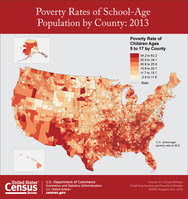
According to U.S. Census Bureau estimates released today, the poverty rate for school-age children had no statistical change in 2,199 counties between 2007 and 2013 while 928 counties experienced an increase and 15 showed a decline.
The statistics are from the Small Area Income and Poverty Estimates program, which provides the only up-to-date, single-year income and poverty statistics for all counties and school districts — roughly 3,140 counties and nearly 14,000 school districts nationally. Data from the American Community Survey are an important input to these estimates.
“County school-age child poverty rates are still above their prerecession levels in metropolitan areas of California, Nevada, Arizona, Florida, Georgia, the Carolinas, as well as the coastal areas of the Northeast and Great Lakes states,” said Wesley Basel of the Census Bureau’s Small Area Estimates Branch. “State and local programs use these statistics for distributing funds and managing school programs.”
The findings show there were large concentrations in the South and West of the 972 counties with poverty rates statistically above the national average of 20.8 percent for school-age children. For example, in New Mexico and Mississippi, more than 80 percent of counties had poverty rates statistically greater than the national rate. Across the nation, 15 percent of school districts had poverty rates greater than 30 percent for school-age children.
Conversely, 902 counties had poverty rates for school-age children that were statistically lower than the national rate. In five states, 80 percent of counties had rates lower than the national rate: Connecticut, New Hampshire, North Dakota, Rhode Island and Wyoming.
Of the 40 counties with median household income estimated to be statistically higher than $80,000, more than two-thirds were in the northeast corridor of metropolitan areas stretching from Boston to Washington, D.C. Estimated median household income among these higher-income counties ranged to nearly $120,000. The U.S. median household income was $51,939. |
No comments:
Post a Comment